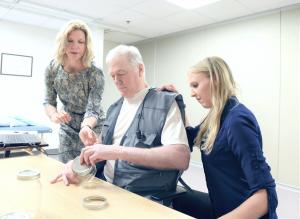New Study: Pairing Nerve Stimulation with Rehabilitation Could Double Improvement of Hand and Arm Function After Stroke
MGH Institute researcher Dr. Teresa Kimberley is senior author of article that reports results have potential to be one of most impressive advances in decades.
In an article published April 22 in The Lancet, “Vagus Nerve Stimulation Paired with Rehabilitation for Upper Limb Motor Function After Ischaemic Stroke (VNS-REHAB): A Randomised, Blinded, Pivotal, Device Trial,” the study reports that patients who incorporated vagus nerve stimulation during physical or occupational therapy showed 2 to 3 times the improvement in arm and hand function compared to those who received intense rehabilitation with sham stimulation.
“How to optimize recovery after a stroke has been studied for decades, but there has been little shown to dramatically improve peoples’ daily lives,” said Dr. Kimberley, who is a senior author on both the pilot and pivotal vagus nerve stimulation studies, directs the MGH Institute’s Brain Recovery Lab, and is a professor of physical therapy at the Boston health sciences graduate school. “Using vagus nerve stimulation paired with repetitions of therapeutic movement appears to help ‘rewire’ the brain to strengthen the brain pathways needed to perform the everyday tasks people want to be able to do. This may be an important new tool to improve people’s lives.”
The 108 patient participants in the study were implanted with a VNS system called Vivistim, produced by MicroTransponder, Inc., an Austin-based, privately held medical device development company, which funded the study. During six weeks of in-clinic therapy followed by three months of home-based therapy, participants received a stimulation of the vagus nerve via a small electrical pulse from a cuff wrapped around the nerve, powered by a unit implanted under the skin near the clavicle. This pulse, delivered during their rehabilitation exercises, essentially helps the brain relearn how to perform tasks such as carrying a grocery bag, using a fork, or casting a fishing line.
Participants in the trial ranged from nine months to 10 years post-stroke. With 50%-60% of the 658,000 yearly stroke survivors in the United States being left with upper extremity motor deficits that persist for months or years, the findings suggest they may be able to improve function and perform some everyday tasks once again.
The study reported there were no unexpected or serious adverse events associated with the Vivistim system.
Kimberley, who has an appointment as research staff at Massachusetts General Hospital Department of Neurology and as core faculty in the hospital’s Center for Neurotechnology and Neurorecovery, acknowledges the large team effort associated with running this trial, which would not have been possible without the multidisciplinary coordination provided by CNTR and the collaborative effort between the MGH Institute, MGH Neurology, and MGH Neurosurgery.
“We are only beginning to understand how to best stimulate the brain to regain function,” said Kimberley, who has researched various types of brain stimulation for over 15 years. “Rehabilitation has always been the key to maximizing recovery after a stroke. Brain stimulation, including methods such as vagus nerve stimulation, may make rehabilitation activity even more impactful and lead to greater gains than we previously thought possible for people with neurologic disorders.”
The Vivistim system currently is being reviewed by the U.S. Food and Drug Administration and by regulatory agencies in the United Kingdom and European Union.
The Lancet article is available online.
The Lancet editorial is available online.
About MGH Institute of Health Professions
Team-based care, delivered by clinicians skilled in collaboration and communication, leads to better outcomes for patients. That’s why MGH Institute of Health Professions graduate school in Boston integrates interprofessional education into its academic programs. Approximately 1,600 students at its Charlestown Navy Yard campus learn and collaborate in teams across disciplines as they pursue post-baccalaureate, master’s, and doctoral degrees in genetic counseling, nursing, occupational therapy, physical therapy, physician assistant studies, speech-language pathology, health professions education, and rehabilitation sciences. The interprofessional learning model extends to hundreds of hospital, clinical, community, and educational sites in Greater Boston and beyond.
The MGH Institute is the only degree-granting affiliate of Mass General Brigham, New England’s largest health provider. It has educated more than 8,900 graduates since its 1977 founding. It is fully accredited by the New England Commission of Higher Education. Several programs are highly ranked by U.S. News & World Report. For the past ten years, the IHP has been named a “Great College to Work For.”
John M Shaw
MGH Institute of Health Professions
+1 978-761-0313
email us here
Legal Disclaimer:
EIN Presswire provides this news content "as is" without warranty of any kind. We do not accept any responsibility or liability for the accuracy, content, images, videos, licenses, completeness, legality, or reliability of the information contained in this article. If you have any complaints or copyright issues related to this article, kindly contact the author above.

